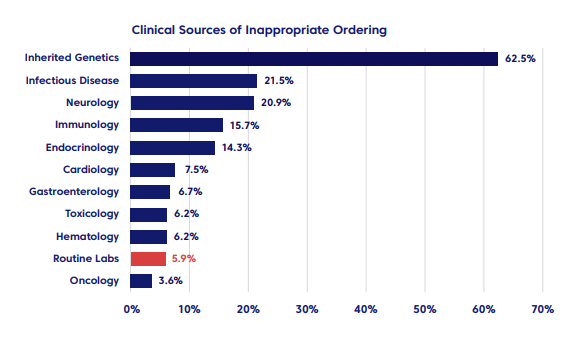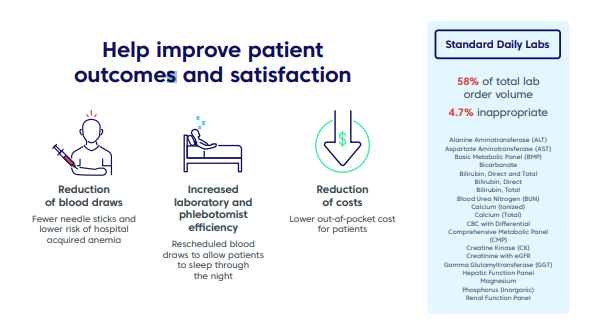7.7 Percent of Lab Orders Clinically Inappropriate, accounting for 12% of the spend
Executive Summary
by Joaquim Cardoso MSc.
Chief Editor
The Health Strategist Blog
March 30, 2022
- The following insights — drawn from Change Healthcare’s CareSelect® Lab point-of-order decision support solution– give providers a unique glimpse into opportunities for decreasing clinically inappropriate laboratory ordering and unnecessary laboratory spend.
- Overall, the study found that approximately 7.7% of all lab orders are clinically inappropriate. These inappropriate orders result in approximately 12% of total laboratory spend to be unnecessary.
- Opportunities to reduce inappropriate ordering and curtail unnecessary spend were not always where you would expect. Large financial and clinical wins exist across the spectrum of testing from genetics to daily labs.
The Baseline: What is Appropriate Ordering?
- To help address root causes of laboratory misutilization, CareSelect® Lab leverages clinical appropriateness criteria authored and maintained by experts at Mayo Clinic.
- All the ordering transactions in the Lab Ordering Index were measured against this criteria across the following categories.

Laboratory Ordering Trends
- 1 Out of 13 (7.7%) Lab Tests Ordered is Inappropriate
- Inpatient Ordering is Almost 2x More Inappropriate Than Outpatient
– Impatient Ordering is 10.1 %
– Outpatient Ordering is 5.8%
- The Rate of Unnecessary Spend is ~1.5x Greater Than The Rate of Inappropriate Orders
When inappropriate orders are matched against the CMS fee schedule to simulate costs, we found that the 7.7% rate of inappropriate ordering drives a 12.0% rate of unnecessary laboratory spend, a ~1.5x discrepancy
- Consistently Inappropriate Orders Drive Over 45% of Unnecessary Spend
- High-Volume Orders Drive Over 47% of Unnecessary Spend
Where Does Inappropriate Ordering Originate?
- The highest rates of clinically inappropriate ordering originate from more specialized and rapidly evolving laboratory testing.
- Orders for Inherited Genetics lead the pack for their rate of inappropriate ordering.
How Do We Identify Opportunities for Improvement?
- Orders with high rates of inappropriate ordering, like Inherited Genetics, are the some of the easiest opportunities to identify.
- However, focusing solely on inappropriateness percentage can ignore the impact of order volume.
- While Routine Labs only has an inappropriateness rate of 5.9%, it contains tests that are performed at extremely high volumes which has a disproportionate impact on clinical outcomes and spend.
Where Does Unnecessary Spend Originate?
- While Inherited Genetics, due to its high average cost-per test, remains the leader in unnecessary spend, Routine Labs climbs all the way into 3rd place. This disparity is a result the high order volumes and frequent ordering of routine labs.
Standard Daily Labs — 58% of total lab order volume and 4.7% inappropriate
- Alanine Aminotransferase (ALT)
- Aspartate Aminotransferase (AST)
- Basic Metabolic Panel (BMP)
- Bicarbonate Bilirubin, Direct and Total ; Bilirubin, Direct ; Bilirubin Total Blood Urea Nitrogen (BUN)
- Calcium (Ionized) Calcium (Total)
- CBC with Differential Comprehensive Metabolic Panel (CMP)
- Creatine Kinase (CK) ; Creatinine with eGFR
- Gamma Glutamyltransferase (GGT)
- Hepatic Function Panel Magnesium
- Phosphorus (Inorganic)
- Renal Function Panel
ORIGINAL PUBLICATION (excerpted version)

The Change Healthcare 2021 Laboratory Ordering Utilization Index
Executive Summary (by Change Healthcare)
The following insights — drawn from Change Healthcare’s CareSelect® Lab point-of-order decision support solution– give providers a unique glimpse into opportunities for decreasing clinically inappropriate laboratory ordering and unnecessary laboratory spend.
Overall, we found that approximately 7.7% of all lab orders are clinically inappropriate. These inappropriate orders result in approximately 12% of total laboratory spend to be unnecessary.
Overall, we found that approximately 7.7% of all lab orders are clinically inappropriate. These inappropriate orders result in approximately 12% of total laboratory spend to be unnecessary.
Opportunities to reduce inappropriate ordering and curtail unnecessary spend were not always where you would expect. Large financial and clinical wins exist across the spectrum of testing from genetics to daily labs.

Our Baseline: What is Appropriate Ordering?
To help address root causes of laboratory misutilization, CareSelect® Lab leverages clinical appropriateness criteria authored and maintained by experts at Mayo Clinic.
All the ordering transactions in the Lab Ordering Index were measured against this criteria across the following categories.

Laboratory Ordering Trends
- 1 Out of 13 (7.7%) Lab Tests Ordered is Inappropriate
- Inpatient Ordering is Almost 2x More Inappropriate Than Outpatient
– Impatient Ordering is 10.1 %
– Outpatient Ordering is 5.8% - The Rate of Unnecessary Spend is ~1.5x Greater Than The Rate of Inappropriate Orders
When inappropriate orders are matched against the CMS fee schedule to simulate costs, we found that the 7.7% rate of inappropriate ordering drives a 12.0% rate of unnecessary laboratory spend, a ~1.5x discrepancy

- Consistently Inappropriate Orders Drive Over 45% of Unnecessary Spend
Orders placed inappropriately more than 90% of the time drive over 45% of unnecessary spend. These orders tend to be lower volume, but high inappropriateness rates combine with a high average cost-per-test to present a large financial opportunity.

- High-Volume Orders Drive Over 47% of Unnecessary Spend
Orders placed inappropriately less than 30% of the time drive over 47% of unnecessary spend. While a majority of these tests are ordered appropriately, these orders are placed in such high volumes that they have a disproportionate effect on unnecessary spend.

- Uncovering Orders that Disproportionately Impact Unnecessary Spend
The bottom end of the appropriateness spectrum reveals a group of exams that feature the biggest disparity between inappropriate percentage and unnecessary spend.
Orders placed inappropriately between 7.5% and 10% of the time drive over 14% of unnecessary spend.

Sources of Inappropriate Ordering and Unnecessary Spend
Where Does Inappropriate Ordering Originate?
- The highest rates of clinically inappropriate ordering originate from more specialized and rapidly evolving laboratory testing.
- Orders for Inherited Genetics lead the pack for their rate of inappropriate ordering.
- As new tests are brought to market and best-practice recommendations are updated the ordering of genetic testing is only becoming more complicated for providers

How Do We Identify Opportunities for Improvement?
- Orders with high rates of inappropriate ordering, like Inherited Genetics, are the some of the easiest opportunities to identify.
- However, focusing solely on inappropriateness percentage can ignore the impact of order volume.
- While Routine Labs only has an inappropriateness rate of 5.9%, it contains tests that are performed at extremely high volumes which has a disproportionate impact on clinical outcomes and spend.

Where Does Unnecessary Spend Originate?
- The highest rates of unnecessary spend originate from across the spectrum of laboratory tests.
- While Inherited Genetics, due to its high average cost-pertest, remains the leader in unnecessary spend, Routine Labs climbs all the way into 3rd place.
- This disparity is a result the high order volumes and frequent ordering of routine labs.

Focus on Orders That Disproportionally Affect Outcomes
“Reducing inappropriate laboratory ordering begins with understanding not just where inappropriate ordering is most likely to occur, but where its reduction will create the greatest impact.
Identifying orders that are routinely placed inappropriately is a good start, but it’s also critical to be able to identify ordering patterns that can disproportionally affect clinical, operational, and financial outcomes.”
Caroline Liebscher Product Manager, CareSelect® Lab Change Healthcare
The Impact of Repetitive Ordering
Ordering Tests Too Often Adds Up Quickly
- Frequency criteria measures repetitive ordering that is not clinically necessary.
- Many laboratory studies, including most Routine Labs, have best-practice guidelines for inpatient ordering frequency. Tests may only be appropriate to order once a day, once every three days, once a year, or even once in a lifetime.
- This analysis examines 130 clinical indications that can be measured against Frequency criteria.

Reducing Daily Labs Helps Improve the Quality of Care
- Due to their extremely high volumes and frequent ordering, the 19 daily labs included in our analysis represent a unique opportunity for organizations to reduce unnecessary spend, increase laboratory efficiency, and, perhaps most importantly, improve the quality of care.

Standard Daily Labs — 58% of total lab order volume and 4.7% inappropriate
- Alanine Aminotransferase (ALT)
- Aspartate Aminotransferase (AST)
- Basic Metabolic Panel (BMP)
- Bicarbonate Bilirubin, Direct and Total ; Bilirubin, Direct ; Bilirubin Total Blood Urea Nitrogen (BUN)
- Calcium (Ionized) Calcium (Total)
- CBC with Differential Comprehensive Metabolic Panel (CMP)
- Creatine Kinase (CK) ; Creatinine with eGFR
- Gamma Glutamyltransferase (GGT)
- Hepatic Function Panel Magnesium
- Phosphorus (Inorganic)
- Renal Function Panel

Managing Laboratory Utilization: Five Tips
1.Create a governance structure to oversee your utilization management program
Effective governance is crucial to align your clinical and financial goals and successfully manage a data-driven laboratory stewardship program.
2. Establish a standard of care for laboratory appropriateness
Identifying and measuring against a referenceable baseline for laboratory appropriateness is the key to driving successful utilization management.
3. Leverage data to prioritize your clinical quality goals
Prioritization is crucial to ensuring your efforts are targeted and improve care.
4. Align remediation strategies based on which actions will have the greatest ROI
Provider education, EHR configuration updates, and point-of-order guidance can all help to increase appropriate utilization and reduce unnecessary costs.
5. Choose the right partner to optimize your laboratory stewardship program
Partner with a vendor that is committed to helping you build a successful and comprehensive laboratory stewardship program.
Originally published at https://www.changehealthcare.com
Names cited
Caroline Liebscher Product Manager, CareSelect® Lab Change Healthcare
Rachael Hulshizer Manager of Clinical Products and Services Value-Based Medicine | Mayo Collaborative Services












